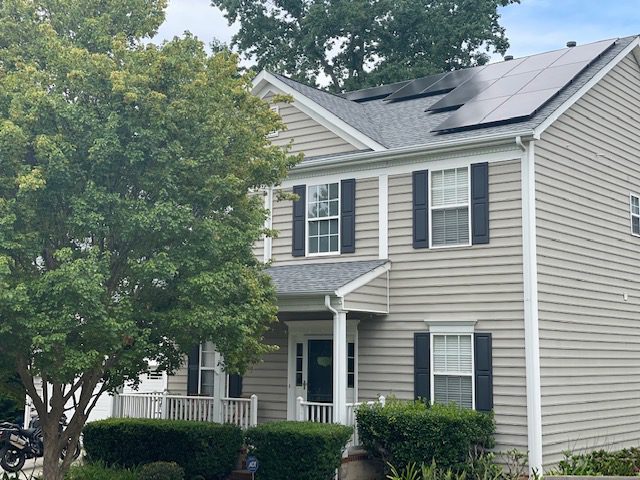Solar power is more popular with homeowners than ever before, with installations on the rise especially here in North Carolina. If you’ve been wondering if it’s time to take the plunge for yourself, our team is here to help guide you through the decision. The first step is to learn all about the advantages and disadvantages of going solar in Charlotte, NC.
From there, you can make a more informed decision about whether to move forward with a solar installation in Charlotte, NC with the help of the SHS Pros team.
Advantages of Solar Power
You Can Reduce Your Electric Bill
With energy costs on the rise, installing a solar panel system is an excellent way to save on your monthly power bills. Our team is here to help you determine how many panels you need to produce an adequate amount of energy to power your home for less. You can also learn more about how to calculate your household energy usage.
You’ll Have Protection Against Blackouts
Unfortunately, it’s only a matter of time before a powerful storm will knock out the electric grid, leading to an inconvenient (and often unsafe) blackout. With a solar power system, you can use solar energy to power your home when your neighbors are experiencing a blackout. This can help keep your family safe and comfortable, even during the worst storms.
Although not all solar systems provide protection against blackouts, there are affordable solutions available for homeowners to backup some or all of their electricity needs. At SHS, we offer battery backup options in various configurations. We take pride in providing reliable backup power solutions for our customers.
This solar-powered Florida community is a great example of the power of solar energy in the event of a storm.
It’s a Clean Energy Source
Fossil fuels release harmful byproducts into the air when they’re burned to create energy. And beyond that, they’re a declining resource. Solar power, on the other hand, is a renewable energy source that can help minimize the use of fossil fuels and lessen the impact on the environment.
If making green, sustainable energy choices around your home is important to you, take advantage of the benefits of solar energy to the environment.
It Can Help Increase Your Home Value
Buyers appreciate solar panels, so if you plan to sell your home in the next several years, you will likely notice an increase in your home value by adding solar panels. Just how much added value can you expect? According to a report from the National Renewable Energy Laboratory, you can expect your home value to increase by $20 for every $1 reduction in annual utility bills.
There Are Solar Tax Credits to Help Offset the Cost
As of August 2022, Congress passed an extension of the federal solar tax credit, offering a 30% credit for all systems installed between 2022 and 2032. These tax credits are set to decrease starting in 2033 and expire completely in 2035 unless there is a renewal.
If you want to help offset the cost of your solar panel system, plan your project now to make the most of these credits.
Disadvantages of Solar Power
When considering the advantages and disadvantages of going solar in Charlotte, NC it’s important to weight the values of both the good and the bad variables. Their are some great benefits to getting solar, but only if it’s right for you. Here are some disadvantages for getting solar.
High Initial Cost
One of the primary reasons homeowners hesitate to install solar panels is the initial investment. Even though technological advances have helped to lower the cost of solar panels, it can still be difficult to justify spending several thousand dollars on your system.
As one of the leading solar panel installers in Charlotte, NC, our team is proud to offer financing options to make it easier for you to pay for your installation.
Relocation Is Difficult
As we mentioned above, solar panels can help increase your home value, which is great if you’re planning to sell your home. But, what if you want to take your solar investment with you? Unfortunately, uninstalling and moving solar panels is difficult and expensive, so relocating them is not usually an option.
Think about how long you plan to stay in your home before deciding whether to install solar panels. At the same time, if you end up moving, your house will have its own power-producing asset and future homeowners can look forward to reduced electricity bills.
Space May Be an Issue
A solar panel system and its various parts can take up a lot of space. Depending on the size and layout of your home, it may be hard to find enough space for your system that will receive adequate sun exposure. Our team can come to inspect your home to help you determine if you have enough space for a system that will fit your needs.
Schedule Your Solar Panel Installation Today
After reading this post about the advantages and disadvantages of going solar in Charlotte, NC, we hope you feel more confident deciding whether solar power is the right choice for your home. When you’re ready to get started on your project, please call us at 704-610-1942 or contact us online to set up a free consultation.


